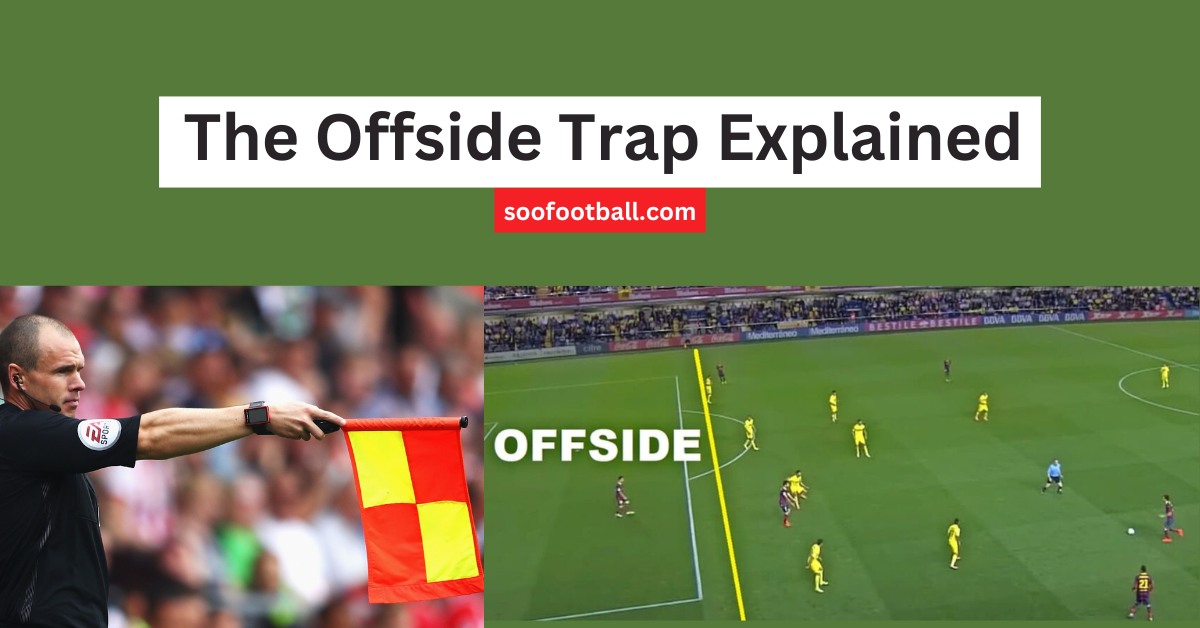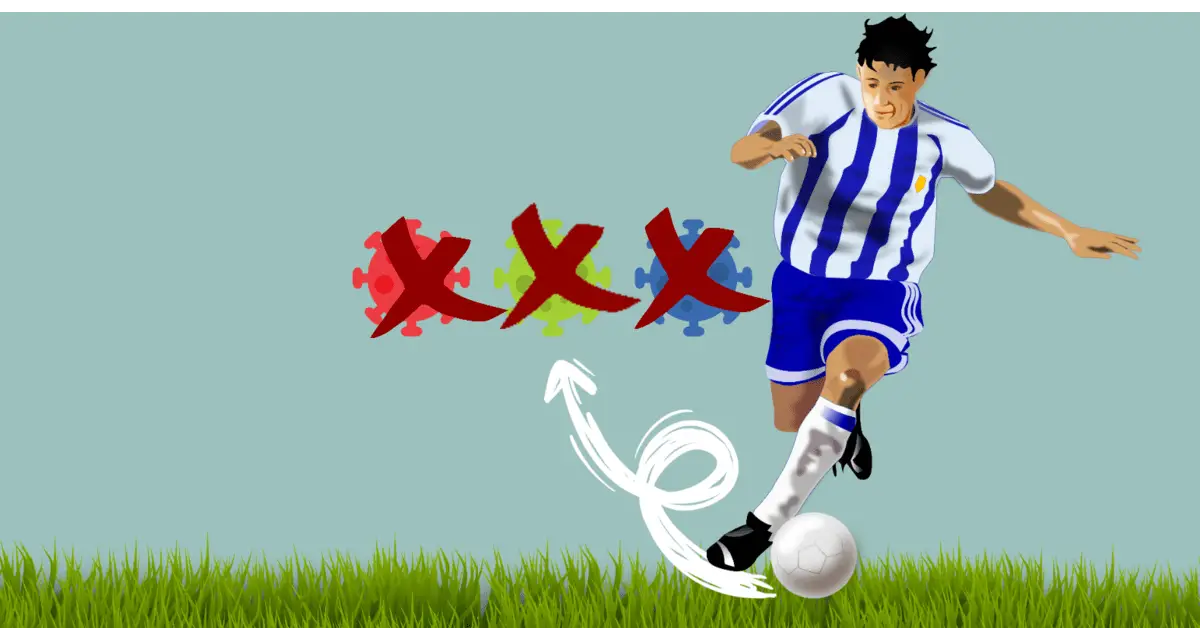This is the most comprehensive guide to Offside Trap In Football.
In the world of football, there are many different ways to outsmart your opponent.
Every team has its unique style of play which can be further broken down into detailed tactics; from how each player should position themselves on the pitch, to what type of pass they should play and when they should do it.
An offside trap is one such tactic aimed at disrupting the rhythm and flow of your opponent’s attack.
It is one of the most defensive and controversial concepts in football.
And fans have been left scratching their heads as to why an obvious goal was disallowed.
However, in this in-depth offside trap explanation, you will learn;
- What is the offside rule in simple terms?
- The meaning of offside trap in football
- History of offside trap – who made the offside trap rule?
- Tactical use of the offside trap in football
- Why is the offside trap used in football
- How effective is the offside trap?
- What are the exceptions when offside will not be called?
- Is it offside if both players are behind the defense?
- Can a player be offside without touching the ball?
- Why is offside not called immediately?
Let’s get started.
What Is The Offside Rule In Simple Terms?
In simple terms, the offside rule states that an attacker cannot be behind the last defender by the time the passer kicks the ball. If he is in such a position, he is offside.
Another important thing of note is that an offside can only take place in a team’s half.
In essence, if the last defender is just before the half-line and the furthest attacker is behind the last defender but in his own half (just before the half-line) before a pass is played, he is not adjudged to be in an offside position.
The offside rule is one of the Laws’ few provisions that have remained the same throughout the history of the game.
What Are The Exceptions When Offside Will Not Be Called?
According to the FIFA rule of offside, there are 3 exceptions when an offside will not be called;
- If a player is in his half of the field of play, then an offside will not be called.
- An offside will not be called If a player receives the ball from a throw-in.
- An offside will not be called if there is no part of the attacking play either head, body, or feet that is closer to the opponent’s box than the final defender except the goalkeeper.
History Of Offside Trap
This tactic has been in use for decades, with the first known recordings of it dating back to the mid-1930s.
Who Made The Offside Trap Rule? Well, nobody knows for sure.
But in the early 20th century, the Offside trap was pioneered by Notts County, in England, which is the oldest football club in the world.
There are various theories as to when and where the tactic was first devised.
Some say it was the Austrian Wunderteam of the 1930s that first used the offside trap to devastating effect.
Whatever the case, we can say that the offside trap has been in use since 1930.
Can A Player Be Offside Without Touching The Ball?
Yes, a player can commit an offside offense without actually touching the ball.
According to FIFA offside offense, a player can be in an offside position if he or she interferes with the play or an opponent by challenging an opponent for the ball or making an obvious action that affects the ability of an opponent to play the ball.
In fact, a player can be in an offside position if he or she is moving toward the ball to play the ball without actually touching the ball.
The Meaning Of Offside Trap In Football
An offside trap is a defensive tactical step where the last defenders try to be on the same line just to ensure the furthest attacker is (by any margin) behind the last defender just so the Linesman can adjudge him offside and thereby render their attack useless.
This is done in the hope that the referee will stop playing (the whistle is blown) and award a free kick to the defending team.
It is called a trap because it is a bit mischievous. The defending team tries to render the opponent’s attack useless while the attacking team tries to beat the trap.
Tactical Use Of The Offside Trap In Football
The idea behind the offside trap is to lure the attacking team into an offside position.
Coaches use this tactic in any formation; 4-4-2, 4-3-3, 3-5-2, etc.
In addition, the offside trap can work with any tactical setup like counter-attack or others.
However, most times, the offside trap is used when a team keeps a high line of defence and is desperately in search of a goal.
Why Is The Offside Trap Used In Football?
The main reason why the offside trap is used in football is to stop an opponent’s attack and regain possession of the ball.
In addition, you can only win a match when you are in possession of the ball.
Setting the Offside trap is one way a team can regain possession, hence, improve their chance of winning.
Why Is Offside Not Called Immediately?
Former premier league referee, Chris Foy explains why offside is not called immediately.
When an immediate goalscoring opportunity is likely to occur, the assistant referee will keep their flag down if they think there is an offside until the passage of play is completed.
Once a goal is scored or the chance is gone, the assistant will raise the flag to indicate Offside and the VAR will review the offside call.
The Disadvantage of Offside Trap
The major disadvantage of the Offside trap tactic is the risk of not correctly ruling for offside due to human error.
However, since adopting the VAR technology, such risk is minimized (not completely eradicated).
The VAR team reviews almost all goals to check if there is any case of offside in the buildup.
Of course, you’d agree that the technology can better adjudge offside better than a human Linesman.
Another disadvantage of the Offside trap is the difficulty of staying on the same (imaginary) line of defense with your teammate.
Sometimes, Defenders fail to stay on the same line thereby keeping the attacker onside.
How To Beat The Offside Trap In Football
Beating the offside trap can be technical and the timing is crucial.
To be realistic, it’s difficult to be onside often, especially when you are new to a team or playing with your teammates for the first time.
This is part of the chemistry that shows the beauty of the game.
However, we’ll share with you some techniques that have seen great forwards implement to beat an offside trap.
Here are techniques to beat an offside trap:
- Play the through ball earlier
- Run from the deep
- Watch the last Defender and Get back to onside Position
- Standing in an offside position without interfering with the ball
1. Play The Through Ball Earlier
As an attacking player, encouraging your teammates to play the through ball earlier most especially in the final third could help beat an offside trap.
But in reality, this has proven to be difficult for some players.
In addition, as a forward for you to be able to implement this technique effectively, you must have built that understanding to play around your creative players.
2. Run From The Deep
When attackers make an unexpected run from deep, a defence can be caught unaware, and it could well beat a set offside trap.
3. Watch the last Defender and Get back to onside Position
Today, modern-day attackers time their run intelligently. They watch the last defender closely.
When attackers observe that they are behind the last defender, they track back to an onside position before attempting another run if need be.
4. Standing In An Offside Position Without Interfering With Play
An attacker can beat an offside trap by standing still, that is without showing a sign of interference toward the ball.
This is a bit of an experienced technique when you find yourself in an offside position, as a forward, what you only need to do is to stand still and make no attempt to go for the ball even if your teammates pass the ball to you.
And for you to beat the trap, one of your teammates could run from an onside position to get on the ball, and after this, you can join the play.
Conclusion
The Offside trap is not the most prominent tactic in modern football but it is still very effective.
Although it is a risky tactic, the Offside trap, when used to devastating effect, can propel a team to victory.
Hungary’s Magical Magyars used the tactic to win the Gold Medal at the 1952 Olympic Games.
Even today, teams use it occasionally at intervals of the game.
Many coaches find the trap frustrating but it is a legitimate tactic used in football and should be respected.
Further Reading:





